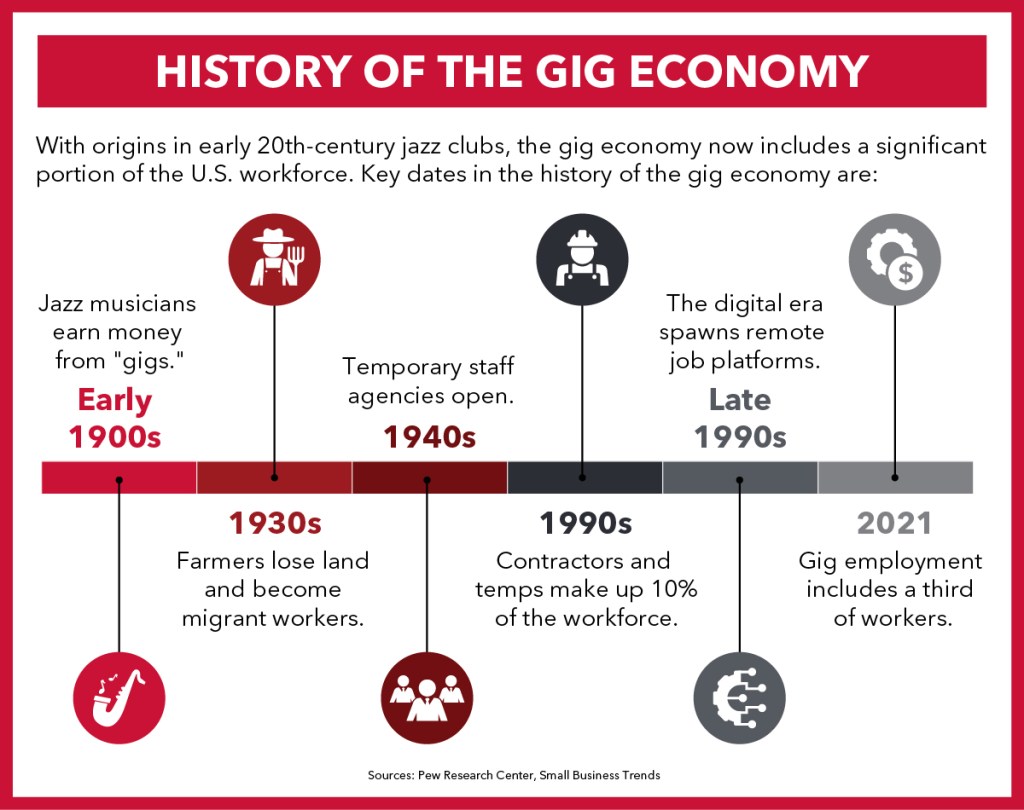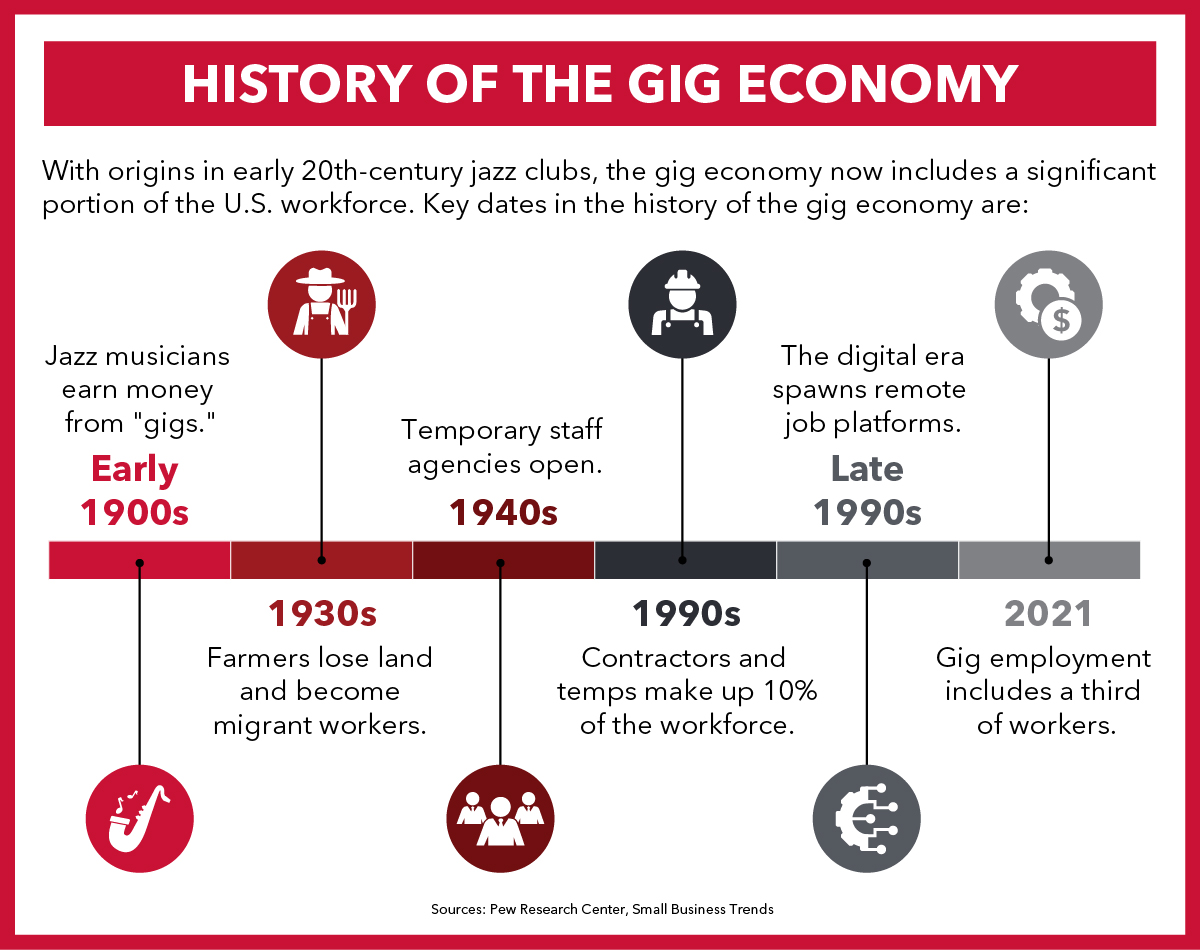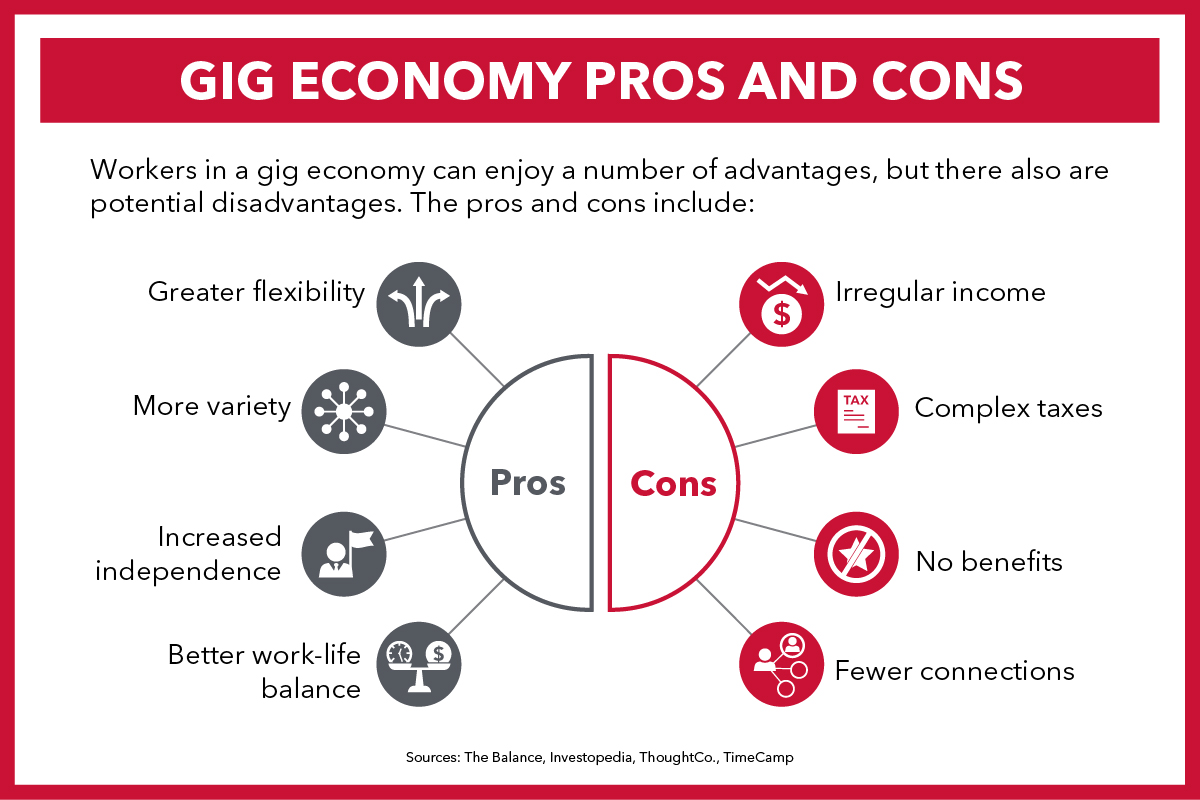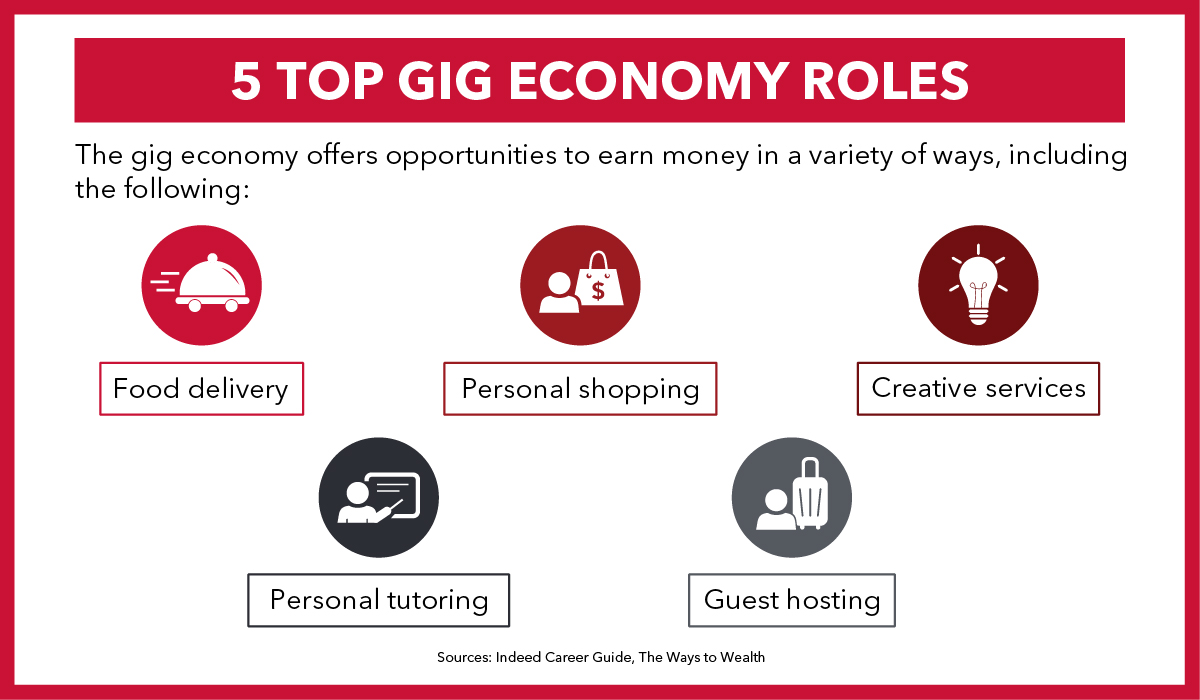What Is the Gig Economy, and Who Are Its Workers?

The gig economy comprises a broad swath of the American population. From food delivery drivers to web designers — and a wide variety of workers in between — the gig economy included nearly 65 million people in the United States in 2022, according to job platform MBO Partners.
And the popularity of working in the gig economy shows no signs of slowing. Projections indicate that by 2028, freelancers who perform gig work will total 90 million and account for more than half of the U.S. workforce, Statista reports.
But what is the gig economy? It’s a system in which, instead of working as traditional, full-time employees for a business or organization, people earn money from individual, on-demand assignments.
This arrangement provides advantages to workers and the businesses that employ them. The popularity of gig employment platforms that connect workers with the companies and individuals seeking their services reflects the value that the gig economy can hold for both parties.
What Is a Gig Economy?
Coined in news stories in 2009, the term “gig economy” has come to describe the work of individuals whose jobs include a variety of individual projects, consultant roles, and part-time positions. Gig workers don’t receive an annual salary from a single employer, but are paid on a per-project, hourly, or part-time basis instead. Because they aren’t permanent, full-time employees, they don’t receive workplace benefits like health insurance or retirement contributions.
Other terms that describe what the gig economy is include:
- Sharing economy
- Freelance economy
- Access economy
The number of people turning to this type of work continues to grow in the 21st century. However, this method for earning money dates back hundreds of years.
Gig Economy: History
The practice of relying on many individual money-making opportunities as a way to earn a living was commonplace until the late 1700s and into the 1800s, when the Industrial Revolution led many workers to full-time manufacturing jobs. Despite the prevalence of full-time employment, one-time or short-term work continued, however, and in the early 1900s, jazz musicians began referring to live-performance jobs at various venues as “gigs.”
Following the turmoil of the Great Depression in the 1930s, gig work dissipated as people sought the stability of full-time positions. But the emergence of the internet changed this trend. Coupled with other factors, such as changing population demographics and financial concerns, digital services helped to create what the gig economy is today.

Add This Infographic to Your Site
<p style="clear:both;margin-bottom:20px;"><a href="https://mvu-umt.vip-uat.twoyou.co/blog/what-is-the-gig-economy/" rel="noreferrer" target="_blank"><img src="https://mvu-umt.vip-uat.twoyou.co/wp-content/uploads/sites/97/2023/02/History-of-the-Gig-Economy.jpg" alt="The gig economy’s development since the early 1900s." style="max-width:100%;" /></a></p><p style="clear:both;margin-bottom:20px;"><a href="https://mvu-umt.vip-uat.twoyou.co" rel="noreferrer" target="_blank">Maryville University </a></p>: With origins in early 20th-century jazz clubs, the gig economy now includes a significant portion of the U.S. workforce. Key dates in the history of the gig economy, according to the Pew Research Center and Small Business Trends, are: Early 1900s: Jazz musicians earn money from “gigs.” 1930s: Farmers lose land and become migrant workers. 1940s: Temporary staff agencies open. 1990s: Contractors and temps make up 10% of the workforce. Late 1990s: The digital era spawns remote job platforms. 2021: Gig employment includes a third of workers.
Internet Platforms
In 1995, online platform Craigslist began posting classified ads, including those seeking paid help on a variety of projects. Other online job platforms followed, with many of today’s gig workers using these resources to find the types of individual, on-demand jobs that were prevalent hundreds of years ago.
From food delivery through DoorDash to marketing services through Upwork, the internet and smartphone apps now provide myriad opportunities for people to earn money by providing assistance on an on-demand basis instead of — or in addition to — filling full-time roles.
In 2021, 16% of Americans reported earning money through online gig platforms, Pew Research Center reports, and 31% of those who used these platforms had relied on them as their main source of income over the previous 12 months.
Workforce Demographics
Shifts in workforce demographics also have contributed to the rise in the number of gig economy roles, with the emerging younger population of workers relying more heavily on this type of work. These workers tend to prefer flexible work arrangements.
Millennials (those born between 1981 and 1996) comprised the largest percentage of gig workers, 34%, according to the 2022 report from MBO Partners. Millennials and the other youngest age cohort surveyed, Generation Z — born between 1997 and 2012 — together account for about half, or 49%, of those working in an independent capacity.
Demand for flexible work options is helping to fuel gig work’s popularity, a 2020 survey from remote job platform FlexJobs shows. Among respondents, 82% of millennials reported that work flexibility was a top factor in considering a job.
Financial Downturns
During the global recession between 2007 and 2009, many people who were struggling to find full-time jobs turned to gig work to earn money. This same issue arose with the emergence of the COVID-19 pandemic in 2020.
But what grew out of a necessity for workers in need of income and companies looking to cut costs related to hiring workers has become a longer-term trend. In fact, 81% of business owners surveyed said freelance workers assist their organizations, according to a 2022 report from freelance online marketplace Fiverr.
Benefits of a Gig Economy
Gig workers help meet the demands of a society that wants efficiency, options, and convenience, such as quickly connecting with skilled laborers or finding temporary lodging. The potential benefits of a gig economy also extend to its workers and the companies that hire them, which is a key reason why gig workers play an important role in an array of industries — from delivery drivers in food service to adjunct professors in higher education.
For employees, the creativity and flexibility that using gig workers can offer have made it an increasingly desirable hiring option.
What Does the Gig Economy Offer Workers?
Seventy-nine percent of Americans who work in the gig economy are more satisfied than they were in traditional jobs, a 2022 study from Brodmin, a late-payment collection service, shows. Following is what the gig economy offers that can lead to increased worker satisfaction:
- Work variety — Whether they have multiple clients or a number of tasks to complete, gig workers can enjoy interesting and varied work experiences.
- Location options — Because of the remote nature of many gig work jobs, people who hold these jobs often can work from anywhere in the world and connect with potential clients from anywhere.
- Work-life balance — Without the set hours and on-site demands of a full-time employer, gig workers often have the flexibility to work whenever and wherever they want, allowing them to schedule their workdays around their other commitments.
- Independence — Because they work off-site, gig workers typically don’t have to contend with the interruptions and frequent meetings that can accompany full-time positions. They are their own bosses, answering to themselves and choosing the work they want to do.

Add This Infographic to Your Site
<p style="clear:both;margin-bottom:20px;"><a href="https://mvu-umt.vip-uat.twoyou.co/blog/what-is-the-gig-economy/" rel="noreferrer" target="_blank"><img src="https://mvu-umt.vip-uat.twoyou.co/wp-content/uploads/sites/97/2023/09/Gig-Economy-Pros-and-Cons.jpg" alt="The positives and negatives of gig work." style="max-width:100%;" /></a></p><p style="clear:both;margin-bottom:20px;"><a href="https://mvu-umt.vip-uat.twoyou.co" rel="noreferrer" target="_blank">Maryville University </a></p>Workers in a gig economy can enjoy a number of advantages, but there also are potential disadvantages. The Balance, Investopedia, ThoughtCo., and TimeCamp present some pros and cons. Pros: greater flexibility, more variety, increased independence, and better work-life balance. Cons: irregular income, complex taxes, no benefits, and fewer connections.
What Does the Gig Economy Offer Employers?
Businesses and individuals hiring workers also can gain advantages from the gig economy. The arrangement can provide employers with cost savings. For example, each contractor saves companies more than $800 a month compared with the salary and benefits for a traditional employee, according to a 2020 report from payroll company ADP.
What the gig economy offers to businesses can be positive in a number of other ways as well. Advantages include the following:
- Broad talent pool — With many gig opportunities available remotely, businesses hiring these workers often can select from people from all over the world.
- Less costly support — Because gig workers are responsible for their own benefits, such as health insurance and time off, companies can gain the productivity of additional workers without being responsible for these expenses.
- Fewer requirements — Since they aren’t full-time employees and often work off-site, gig workers typically don’t need the onboarding and office space that a traditional employee generally requires.
- Less risk — When businesses hire gig workers, the jobs often aren’t long-term engagements, making it less risky than hiring full-time employees.
Working in the Gig Economy
What is the gig economy workforce? Its workers act more as entrepreneurs than as traditional employees, independently promoting their services and seeking clients and work assignments. They often can set their own hours, depending on the role. Virtual assistants, who provide administrative help, might work during the business hours of their clients, for example, while food delivery drivers might choose to work only a few evenings a week.
What Is a Gig Economy Worker?
The gig economy includes freelancers and independent contractors, who work for themselves. Freelancers generally serve multiple clients simultaneously, while independent contractors may work with a single client on a long-term project.
Contingent workers are another part of the gig economy. These workers hold roles in companies that are similar to those of traditional employees — but, as with freelancers and independent contractors, the work is temporary and doesn’t offer employee benefits. Common examples of gig economy work include:
- Traditional freelance — Providing contracted services to businesses and individuals, including creative work like writing and photography
- Self-employment — Offering services that include skilled trade jobs, with workers that include electricians and plumbers
- Gig marketplace — Performing on-demand work as solicited through online services, with work ranging from property management to grocery shopping
- Other gig opportunities — Earning supplemental income through efforts often called “side hustles,” such as selling goods on eBay or Etsy
Industries That Rely on Gig Workers
Gig economy workers are what many industries rely on to assist their full-time staff or to provide all services their businesses require. Following are gig economy workers’ roles by economic sector, as categorized by the World Economic Forum:
- Asset-sharing services — Renting one’s own property, like homes or cars, to other individuals
- Professional services — Completing projects such as coding or administrative work for individuals, businesses, and organizations
- Handmade goods, household, and miscellaneous services (HGHM) — Selling homemade crafts or offering on-demand household services, including craft sales and pet sitting
- Transportation-based services — Assisting individuals who need transport services, such as through ride-sharing or grocery delivery apps
Gig Economy Examples and Platforms
After learning what the gig economy is, those interested in pursuing this type of work should explore examples of jobs and how to get them. The many options for pursuing gig work are a testament to gig work’s growing popularity among workers and those who hire them. Following are some gig economy examples by type of job and gig economy platforms.
9 Gig Economy Job Examples
From data entry to delivery service, and from tutoring to tech support, many different types of jobs abound in the gig economy. Jobs available through gig work include:
Administrative Support
Depending on the type of business these workers support, duties can include:
- Scheduling appointments
- Data entry
- Staffing an information desk
- Organizing files
Caregiving
Gig work opportunities include caring for other people, such as babysitting and elder care.
Creative Services
Workers such as graphic designers and writers fall into the category of creative services. Graphic designers use computer software to design items such as ads or logos, and writers can create content ranging from magazine articles to research reports.
Delivery Services
Another type of gig work entails delivering food from restaurants or grocery and household items from stores. Among U.S. adults using apps to find gig work, 7% have made deliveries, and 4% have delivered food or other store-purchased items, according to the 2021 Pew Research report. Another 3% have delivered packages using their own vehicles.
Household Task Support
Six percent of Americans finding work through online apps have provided services such as performing household tasks or running errands, Pew reports. Work can include house cleaning, landscaping, and home maintenance and repair tasks.
Rentals
People can earn money through short-term rentals of their possessions. Among the opportunities for this type of gig work are renting their homes, cars, or boats.
Transportation
Five percent of American adults who have used apps to find gig work have provided ride-sharing services, Pew reports. These drivers typically use their own vehicles to transport people as requested.
Tutoring
Tutors work with students. They support the efforts of teachers by offering additional assistance in specific subject areas or in test preparation.
Web Development
Web developers create and implement the code required for developing websites. Their work establishes the look and performance of a site.

Add This Infographic to Your Site
<p style="clear:both;margin-bottom:20px;"><a href="https://mvu-umt.vip-uat.twoyou.co/blog/what-is-the-gig-economy/" rel="noreferrer" target="_blank"><img src="https://mvu-umt.vip-uat.twoyou.co/wp-content/uploads/sites/97/2023/09/5-Top-Gig-Economy-Roles.jpg" alt="Five areas of gig work." style="max-width:100%;" /></a></p><p style="clear:both;margin-bottom:20px;"><a href="https://mvu-umt.vip-uat.twoyou.co" rel="noreferrer" target="_blank">Maryville University </a></p>The gig economy offers opportunities to earn money in a variety of ways, including the following, according to Indeed and The Ways to Wealth: food delivery, personal shopping, creative services, personal tutoring, and guest hosting.
Gig Economy Resources: 13 Job Platforms
Those looking for gig work can rely on several methods to connect with the individuals, businesses, and organizations that need their services. Depending on the type of products or services that gig workers provide, they can reach out to companies directly, for example, at conferences and networking events. Or they might create websites that showcase their work.
However, many gig workers are connecting to clients and jobs through online platforms, the Pew Research Center report notes. What are gig economy platforms? They are internet and smartphone app tools, typically focused on specific types of services, that connect gig workers with those who need their assistance. Following are 13 examples of gig economy platforms and the types of gig work that they specialize in:
- 99designs — Graphic designers
- Airbnb — Home rentals
- Angi — Home contractors who perform jobs such as cleaning and decorating (formerly known as Angie’s List)
- DoorDash — Restaurant delivery
- Education First — English and foreign language tutors
- Fiverr — A variety of work, from odd jobs to writing
- Grubhub — Restaurant delivery
- HelloTech — Computer tech support
- Instacart — Shopping for groceries, delivering groceries, or both
- Lyft — Ride sharing
- Uber — Ride sharing
- Uber Eats — Restaurant and grocery delivery
- Upwork — Various roles, such as writing, marketing, translation, and legal assistance
Tips for Success in the Gig Economy
Gig economy workers — and those who hire them — can help ensure their success by following some key tips.
Tips for Workers
Careful consideration of one’s earnings, hours, and networking is important when working in the gig economy. Gig economy workers should:
- Consider their net income. Whether it’s factoring in taxes on their earnings or wear and tear on their equipment, gig workers need to consider how much the cost of required expenses will cut into their gross earnings to ensure they are able to earn a sufficient income from the work to make it a viable option.
- Plan their schedule carefully. Some types of gig work, such as ride sharing or food delivery, can be more lucrative during certain hours, and those can fluctuate. In some other types of gig work, such as creative services, sticking with a set schedule can aid in productivity.
- Establish working relationships. Networking and forming professional relationships with other gig workers can help curb the loneliness that can result from working for oneself.
Tips for Employers
Planning and testing what works best are important steps for individuals and businesses seeking gig workers. Those who rely on gig workers to complete tasks should:
- Identify their needs and skills gaps. Anticipate upcoming projects and the amount of work those projects will require, and consider whether gig workers can help meet the demand.
- Explore different methods for finding workers. Test different approaches to finding gig workers, comparing job platforms and seeking help through professional networks.
- Work with established gig economy platforms. When working with a job platform, ensure that it is established and offers a mechanism for vetting the quality of gig workers’ services before hiring them.
The Gig Economy Is Reshaping the U.S. Workforce
What the gig economy means to the U.S. workforce has shifted dramatically in recent years, with an increasing percentage of people relying on gig work as a source of income. The availability of online tools for finding jobs, coupled with advantages for workers and employers alike, are helping to drive this growth. These factors also make it a good time to explore the many options available for this increasingly popular approach to earning or supplementing an income.
Infographic Sources
The Balance, “What Is the Gig Economy?”
Indeed Career Guide, “What Is a Gig Worker? How to Find a Job in the Gig Economy”
Investopedia, “Gig Economy: Definition, Factors Behind It, Critique & Gig Work”
Pew Research Center, “The State of Gig Work in 2021”
Small Business Trends, “The History and Future of the Gig Economy”
ThoughtCo., “Gig Economy: Definition and Pros and Cons”
TimeCamp, “Gig Economy — What Is It and What It Offers”
The Ways to Wealth, “32 Highest Paying Gig Economy Jobs for 2022”

